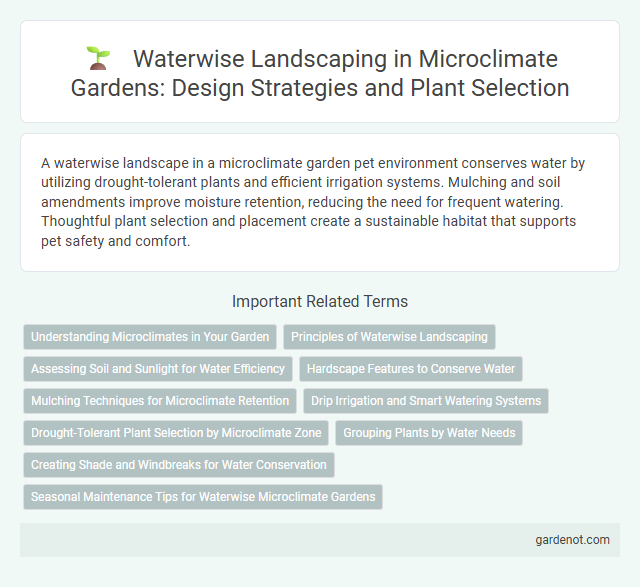A waterwise landscape in a microclimate garden pet environment conserves water by utilizing drought-tolerant plants and efficient irrigation systems. Mulching and soil amendments improve moisture retention, reducing the need for frequent watering. Thoughtful plant selection and placement create a sustainable habitat that supports pet safety and comfort.
Understanding Microclimates in Your Garden
Microclimate gardens thrive by analyzing temperature, sunlight, humidity, and wind patterns unique to specific areas, enabling the selection of waterwise plants adapted to local conditions. Understanding these microclimates reduces irrigation needs by promoting plant species resilient to drought and heat fluctuations. Implementing mulches, shade structures, and soil amendments enhances moisture retention and supports sustainable waterwise landscaping.
Principles of Waterwise Landscaping
Waterwise landscaping focuses on principles such as selecting drought-tolerant native plants, efficient irrigation techniques, and soil improvement to maximize water retention. Key strategies include zoning plants by their water needs, using mulch to reduce evaporation, and capturing rainwater through rain gardens or rain barrels. These practices conserve water resources while maintaining a thriving, sustainable microclimate garden.
Assessing Soil and Sunlight for Water Efficiency
Assessing soil type and sunlight exposure is crucial for optimizing water efficiency in a waterwise landscape. Sandy soils drain quickly and require drought-tolerant plants, while clay retain moisture, supporting a different planting strategy. Evaluating sun exposure helps select plants suited to varying light conditions, reducing irrigation needs and promoting sustainable microclimate garden management.
Hardscape Features to Conserve Water
Hardscape features such as permeable pavements, gravel paths, and stone mulches play a vital role in a waterwise landscape by minimizing water runoff and promoting efficient water absorption. Incorporating rain gardens and dry creek beds directs and retains stormwater, reducing irrigation needs while preventing soil erosion. Utilizing shade structures and strategically placed boulders helps lower soil temperatures, further conserving moisture in microclimate garden environments.
Mulching Techniques for Microclimate Retention
Mulching techniques significantly enhance microclimate retention in waterwise landscapes by reducing soil evaporation and maintaining consistent moisture levels. Organic mulches such as wood chips, straw, and compost improve soil structure and temperature regulation, creating a cooler, more stable environment for plants. Implementing thick mulch layers around drought-tolerant plants minimizes water loss and supports efficient irrigation practices, promoting sustainable microclimate management.
Drip Irrigation and Smart Watering Systems
Drip irrigation delivers water directly to plant roots, reducing evaporation and runoff in microclimate gardens by up to 30%, enhancing water efficiency. Smart watering systems use soil moisture sensors and weather data to optimize irrigation schedules, potentially cutting water use by 40%. Integrating these technologies supports sustainable waterwise landscapes by maintaining plant health while conserving vital water resources.
Drought-Tolerant Plant Selection by Microclimate Zone
Waterwise landscaping in a microclimate garden emphasizes selecting drought-tolerant plants adapted to specific microclimate zones, optimizing water conservation and plant health. Understanding sun exposure, soil type, and wind patterns within microclimate zones allows targeted plant choices like succulents, native grasses, and xerophytes that thrive with minimal irrigation. Strategic zoning reduces water usage by up to 50%, promoting sustainable gardening in arid and semi-arid regions.
Grouping Plants by Water Needs
Grouping plants by water needs enhances waterwise landscape efficiency by reducing waste and optimizing irrigation. Placing drought-tolerant species together minimizes water use while ensuring each plant receives appropriate moisture levels. This strategy conserves water resources and supports sustainable, resilient microclimate gardens.
Creating Shade and Windbreaks for Water Conservation
In waterwise landscaping, creating shade and windbreaks significantly reduces evaporation and conserves soil moisture. Strategically planted trees and shrubs provide natural cooling and protect plants from harsh winds, decreasing irrigation needs by up to 50%. Incorporating native drought-tolerant species in these areas enhances microclimate benefits, promoting sustainable water management in gardens.
Seasonal Maintenance Tips for Waterwise Microclimate Gardens
Seasonal maintenance for waterwise microclimate gardens involves adjusting irrigation schedules to match changing rainfall and temperature patterns, reducing water waste. Mulching with organic materials like wood chips retains soil moisture and suppresses weeds, essential for drought-resistant plants such as succulents and native grasses. Pruning sun-adapted shrubs and removing dead foliage promotes healthy growth and enhances water absorption efficiency in these specialized microclimates.
Waterwise landscape Infographic

 gardenot.com
gardenot.com